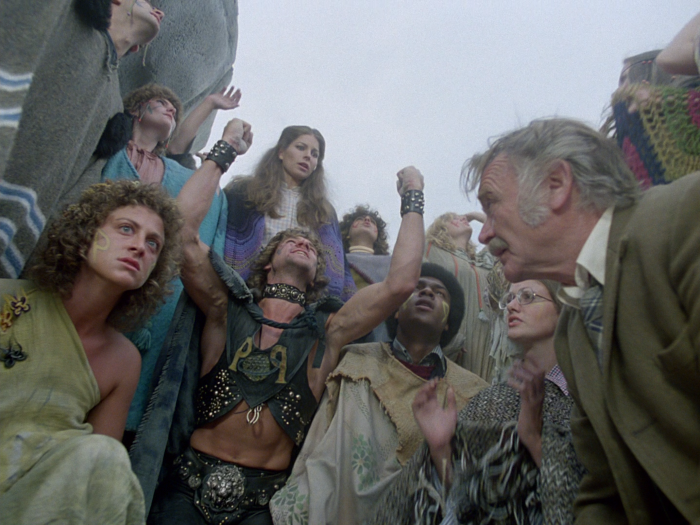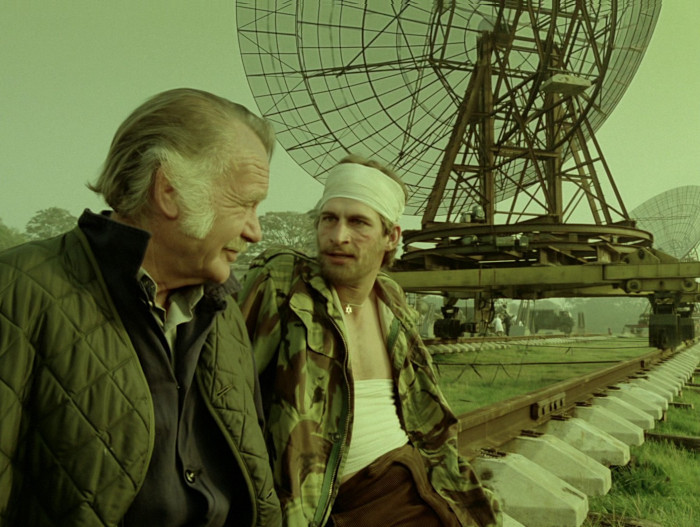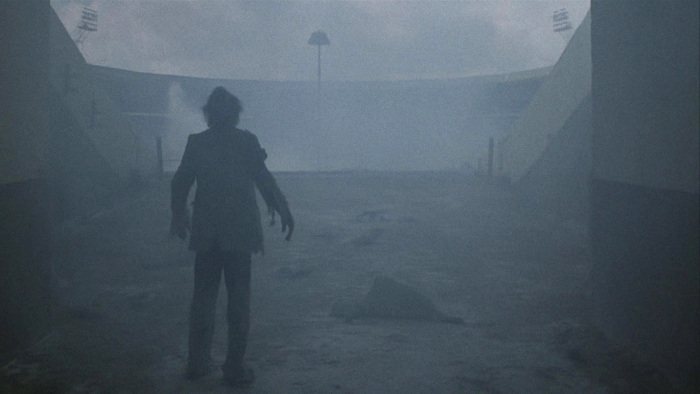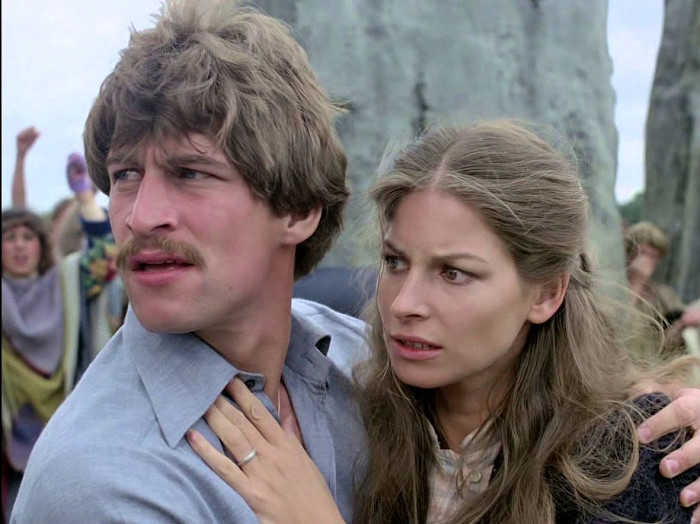Back in 1972, Nigel Kneale returned to his greatest creation, Professor Bernard Quatermass, for a fourth and final serial for the BBC, following The Quatermass Experiment (1953), Quatermass II (1955) and Quatermass and the Pit (1958-1959), all adapted for the big screen by Hammer Films in 1955, 1957, and 1967 respectively. Kneale had been approached as early as 1965 to revive Quatermass, then at the behest of producer Irene Shubik who wanted to feature the character in an episode of her science fiction anthology series Out of the Unknown, but that had fallen by the wayside. Hammer announced that it too was in talks with Kneale to revive the venerable Quatermass following the release of their film version of Quatermass and the Pit but he eventually returned home to the BBC who commissioned a new 4 part serial in 1972, shortly after Kneale had completed work on The Stone Tape (1972). Much concerned with weight matters like contemporary politics and the future of the space race. The scripts were completed, and Dixon of Dock Green (1955-1976) producer Joe Waters set to work in June 1973, setting up a special effects unit at Ealing Studio under the supervision of Jack Wilkie and Ian Scoones. But the BBC suddenly realised later in the day just how much the enterprise was going to cost them and when they were denied access to Stonehenge, where the climax of Kneale’s series was to have taken place, they pulled the plug.
The BBC’s rights to the scripts expired in 1975 by which time Kneale had decamped to ITV. Quatermass fell into the hands of Euston Films, at the time still best known for producing hit cop show The Sweeney (1975-1978), and company executive Johnny Goodman set in motion an ambitious production that would be made available as both four 50 or so minute episodes (shot ion 35mm film as opposed to the videotape that the BBC were planning to use) and a single feature length (109 minutes) story, much edited, for release overseas as The Quatermass Conclusion.

Set in “the last quarter of the 20th century,” it begins with Quatermass (John Mills, following in the footsteps of Reginald Tate, John Robinson and André Morell on the small screen and Brian Donlevy and Andrew Keir on the big) arriving from his home in Scotland in a violent and run down London patrolled by mercenary pay cops, very posh muggers and brutal, armed street gangs like The Badders (naming themselves after the Baader-Meinhof gang) and the Blue Brigades. He’s rescued from muggers by astronomer Joe Kapp (Simon MacCorkindale) who is also making his way to the television studio. Ostensibly Quatermass is there to take part in a television broadcast covering the “Hands in Space” project, a joint American-Russian space mission. Quatermass rails against the obscenity of this vanity project (“this disgusting charade… what we’re looking at is a wedding – a symbolic wedding between a corrupt democracy and a monstrous tyranny!”) as the world goes to Hell below them. But he’s not so much interested in the space mission as he is with finding his missing teenage granddaughter Hettie (Rebecca Saire) who has run away from home. During the attempted docking of the two spacecraft, they are struck by a powerful force emanating from deep space that destroys both ships. Kapp takes Quatermass to his home in the countryside near a pair of radio telescopes that picked up a powerful signal at the exact time that the space mission was destroyed.
Elsewhere, the hippie-like “Planet People” – who Quatermass believes Hettie has joined – are roaming the countryside, gathering at Neolithic sites like the nearby stone circle Ringstone Round which is later hit by the same beam from space. Quatermass surmises that the beam is harvesting humans, drawing the young to sacred sights to commit acts of violence built on long-forgotten receivers buried there thousands of years earlier when the aliens first visited the planet and feeding on “all the rage of the world.” Similar catastrophes are being reported around the world as large gatherings of young people are destroyed by the “lovely lightning.” Kapp’s wife Clare (Barbara Kellerman) and two young daughters are killed when the beam hits Ringstone Round again, Quatermass is stranded while trying to get to London and throws in his lot with a group of old people who have built a community in a huge car scrap yard, and he survives an alien attack on Wembley Stadium (there’s some nonsense about “sacred turf” that surely even Kneale couldn’t have believed), which he believes was built over one of the receivers. Eventually, with the help of his elderly colleagues – only the young seem to be affected by the hypnotic call to the sacred sites – he develops a bomb that he hopes will deliver a “sting” to the alien predator sufficient to make it thing twice about returning.

As was often the case with Nigel Kneale’s scripts, there’s an awful lot going on in Quatermass, enough indeed for several serials. And while story is endlessly fascinating, it doesn’t all quite hang together as well as it should. The detour to the junk yard and its colony of cheery, Blitz-spirit old duffers drags (it’s entirely missing in the feature length version) and Kneale admitted that he found it hard to write for both formats at the same time. In the full-length version, the scripts sometimes feel unusually rushed or even unfinished, with many lapses in logic and an over-reliance on coincidence and happenstance to keep the plot moving (Hettie just happens to have found her way to Ringstone Round in time for the finale for example). In many respects – and purists may well be aghast at this – the feature length version is actually preferable.
Worrying about the fact that Mill’s version of Quatermass seems very different to earlier portrayals is a fools errand – Quatermass had already been played so differently by so many actors that there probably isn’t one true version of him anyway. Mills places him as older, broken, weary, out of touch with a world full of ever greater terrors than he’d experienced before. The dystopian vision of a rubbish-strewn, war-torn London in the early stages is well realised by director Piers Haggard and his production designer Arnold Chapkis, though it’s not clear if the terribly well-spoken muggers who attack Quatermass are part of some satirical barb or just dreadful miscasting. Maybe they were just Kneale being prophetic again, somehow correctly divining the Eaton/Bullingdon Club bullies that would make their mark on the world decades later…

If that’s the case, it wouldn’t be the only time that Kneale seemed to again be the television prophet of the science fiction age. In his Theatre 625 play The Year of the Sex Olympics (1968) (referenced here in a scene involving a dreadful erotic dance show, Tit-Up-Your-Bumpity, “the only show anyone watches any more” being broadcast to the cowering masses and referred to as a “family show”) he’s presciently imagined a media landscape dominated by reality television and his crystal ball (one suspects that he would hated that sort of reference to the mystical and the paranormal) didn’t let him down here. At the time, Quatermass was mocked in some quarters for portraying the disaffected youth of Britain as a bunch of hippies (lead by Ralph Arliss’ Manson-like Kickalong and numbering Toyah Wilcox among their ranks) obsessed with ley lines and ancient monuments, its first broadcast coming so soon after he first violent flowering of punk. In the wake of the “new age traveller” movement of the 1980s, Kneale suddenly started looking well ahead of his time again. We might even be able to suggest that he predicted the latter half of the 2010s and early 2020s with some accuracy, with his depiction of large groups of people rejecting science in favour of arcane superstition and half-baked conspiracies, where city streets have become war zones, controlled after a fashion by heavy handed and trigger-happy police and where the wealthy cavort about in space while the world burns.
But he was also left looking extraordinarily grumpy, railing against the young who he paints as gullible, quick to violence and easy prey for the alien force. They, and the rest of the world, can only be saved by older, middle class white men like himself and this is the aspect of Quatermass that is still a little too hard to take. His young people are, until the last second perhaps, mainly painted in the broadest strokes – uncontrollable, a threat to the established order that need to be supressed and revelling in their anti-intellectualism (“stop trying to know things!”) Interestingly, Kapp hates the Planet People for their superstitious belief in “the planet” and salvation by alien, yet easily falls back into his religious roots, telling Quatermass that the lighting of candles in a menorah is a “bit of cosy ritual to make everything safe.”

No doubt Kneale saw the young people of the world in 1972 much as Kapp does, eyeing them with distrust and not a little dismay. This wariness would have struck a chord with parents in that post-punk era of 1979 but today it looks a bit like the ravings of an ageing misanthrope – it comes to us all in the end, perhaps, but not all of us put it up there on television screens for just shy of four hours… That said, Kneale’s depiction of the elderly is no less flattering than that of the young. They might conspire in the end to save the day, but they’re mostly presented as a bunch of near-senile, tea-drinking old duffers, cast aside by an uncaring world but still singing the old songs to keep the spirits up.
All of this is so frustrating because if we strip aware the bitterness there’s so much to enjoy here. The notion of an intergalactic cull is a chilling one, the suggestion that this ancient visitor could be responsible for many of the ills of the modern world as it reactivate sits long-buried artefacts compelling and Piers Haggard, no stranger to folk horror (he directed the classic Blood on Satan’s Claw (1970)) makes a decent stab at that it’ll-never-catch-on sub-sub-genre of “folk science fiction” (see also Sky (1975)). There are some marvellous set-pieces and indelible images to be found here – the first attack by the “machine beast” on Ringstone Round; one of the survivors of that attack, Isabel (Annabelle Lanyon) levitating and exploding from her hospital bed; the attack on Wembley Stadium and it’s horrific aftermath, the sky stained green by the “vomit” disgorged by the alien after it’s stuffed itself on tens of thousands of youngsters; the haunting and moving finale. All fantastic moments that linger in the memory and go a long way to erasing memories of the series’ lesser qualities. There are quieter, subtler moments that impress too, like Kapp’s assistant Alison (Brenda Fricker) and Clare slowly succumbing to whatever hold the alien artefacts have over the young.

There are traces of the concerns that had been explored throughout Kneale’s career. The marvellous juxtaposition of the ancient (Ringstone Round) with the modern (Kapp’s nearby satellite dishes) is almost quintessential Kneale, as is the conflict between science and superstition. As was his wont, he declines to write down to his audience – there are no easy answers here, no definitive explanation for what the aliens are. It’s simply unknowable, some awful, ancient and enigmatic force from deep space that retains centuries long control over Mankind, a not-so-distant relations perhaps of the Great Old Ones that stalked the stories of H.P. Lovecraft.
Mills is good as the aged Quatermass, ironically finding a final lease of life amid the mayhem as he uses his intellect for one final hurrah, one last stand against an alien intrusion. Elsewhere the supporting cast is less impressive. McCorkindale, who had previously been in the Baby episode of Kneale’s Beasts (1976), was never the subtlest of actors and here he bellows even the most inconsequential of dialogue (perhaps he was just trying to make himself heard over Nic Rowley and Marc Wilkinson’s terrible synth score), perpetually furious at everybody and everything. He’s rather better in the latter half as Kapp struggles to deal with the loss of his family; Kellerman is too drippy to make much of an impact; and many of the Planet People give the impression that this was their first gig out of stage school and they hadn’t quite come to grips with the subtleties that small screen acting required.

Flawed but endlessly fascinating, Quatermass was the first television broadcast on ITV following the industrial action that had kept the network off air for eleven weeks. It was unusual, possibly brave, possibly foolhardy choice to tempt viewers back, a huge science fiction epic, crammed full of huge ideas but hardly a barrel of laughs. But back then British television did bleak, apocalyptic and despairing like no-one else and viewers were evidently up for it. It marked was the end of the television line for the original incarnation of Kneale’s most famous creation but not quite the last we would hear of Quatermass. He turned up on radio, voiced by Andrew Keir, in The Quatermass Memoirs, set just before the events of Quatermass, first broadcast on BBC Radio 3 in March 1996 and in 2005, he returned to the small screen in a remake of The Quatermass Experiment, broadcast live (like the original) on BBC Four in April 2005 with Jason Flemyng taking over the role.
I saw this one decades ago and your review can bring back some powerful memories. Thanks.
LikeLiked by 1 person